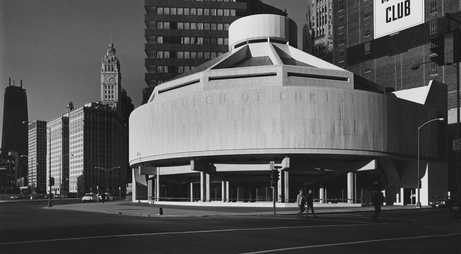-
past events
Iuke Mori Lampo Performance Series Jun 07, 2025 Performance
Weston Olencki & Jennifer Torrence Lampo Performance Series Mar 22, 2025
POSTPONED—Cally Spooner: A Hypothesis of Resistance Mar 15, 2025 Book Launch
A Personal Memory of Frederick Kiesler: Environmental Visionary James Wines Mar 05, 2025 Talk
Madlener House
4 West Burton Place
Chicago, Illinois 60610
Telephone: 312.787.4071
info@grahamfoundation.org

Seventeenth Church of Christ, Scientist, Chicago; designed by Harry Weese and Associates, 1968. Photo by Orlando Cabanban. Printed with permission from W.W. Norton & Company.
55 East Wacker Drive
Chicago, IL 60601
Please note location.
On Tuesday, October 26, the Graham Foundation for Advanced Studies in the Fine Arts will host a free lecture celebrating the release of The Architecture of Harry Weese, a new book by Robert Bruegmann and Kathleen Murphy Skolnik. The public is invited to experience the architecture of Harry Weese firsthand by joining Bruegmann for a lecture on the architect’s legacy in one of his most important buildings, the Church of Christ, Scientist, Chicago. Built in 1968, the church is a consummate example of the architect’s pioneering style and his significant contributions to Chicago’s architectural history. The lecture will be followed by a book signing.
During a career that spanned half a century from the 1930s to the 1980s, Harry Weese (1915 - 1998) produced a large number of significant designs ranging from small but highly inventive houses to large urban scale commissions like the Washington, D.C. Metro system. As the first monograph solely devoted to Weese’s work, the book revives the reputation of a visionary architect. This book takes its place within a fast-growing revival of interest in the work of Weese and a number of his friends and contemporaries with shared assumptions and sensibilities, notably Eero Saarinen, Edward Larrabee Barnes, I. M. Pei, Ralph Rapson, and Paul Rudolph. As important as Weese’s buildings were, though, they were only one part of what almost all his contemporaries recognized as his seemingly inexhaustible creativity. Because Weese believed that design was essentially problem-solving, he was willing to apply his skills to everything from a piece of furniture to an entire city. The city on which he lavished the most attention was his own city, Chicago, where he seemed to be everywhere at once, praising, criticizing, cheerleading, and pouring out ideas for creating a humane and livable place for citizens of all walks of life. Although influenced to some degree by the rational, and often austere, work of European modernists like Mies van der Rohe, in most of his own oeuvre Weese instead followed the example of Nordic architects like Gunnar Asplund and Alvar Aalto in favoring natural materials, human scale, and comfort; his work was characterized by a deep respect for older buildings and existing urban patterns and a fondness for unexpected, often idiosyncratic design decisions.
The Architecture of Harry Weese was supported by a 2004 grant from the Graham Foundation. It is published by W.W. Norton & Company. Books will be available for purchase the day of the event.
ABOUT THE AUTHORS
Robert Bruegmann, an historian of architecture, landscape, and the built environment, is University Distinguished Professor of Art History, Architecture and Urban Planning at the University of Illinois at Chicago. His most recent book is Sprawl: A Compact History (University of Chicago Press).
Kathleen Murphy Skolnik holds an MA in art history with a concentration in architectural history from the University of Illinois at Chicago and teaches art history at Roosevelt University in Chicago.
Copyright © 2008–2025 Graham Foundation. All rights reserved.